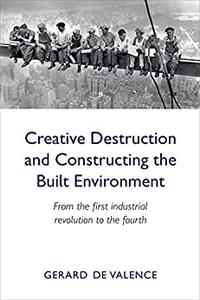Creative Destruction and Constructing the Built Environment From the first industrial revolution to the fourth
- Книги
- 23-02-2023, 00:00
- 199
- 0
- voska89

Creative Destruction and Constructing the Built Environment: From the first industrial revolution to the fourth by Gerard de Valence
English | December 21, 2022 | ISBN: N/A | ASIN: B0BQX5WZBJ | 311 pages | EPUB | 1.43 Mb
How does innovation and fourth industrial revolution technologies affect construction of the built environment?
Industries and products evolve and develop as their underlying knowledge base and technological capabilities increase. The start of a cycle of development is a major new invention, something significant enough to lead to fundamental changes in demand (the function, type and number of buildings), design (the opportunities new materials offer), or delivery (through project management). Major inventions give a 'technological shock' to an existing system of production, which leads to a transition period where incumbent firms have to adjust to the new business environment and new entrants appear to take advantage of the new technology.
This process is known as creative destruction, and over time it leads to the restructuring and eventually consolidation of industries. That is what happened to construction and related suppliers of services, materials and components after the first industrial revolution and architects, engineers and quantity surveyors emerged.
Between 1850 and 1900 construction saw the rise of large, international contractors, who reorganized project management and delivery around steam powered machinery and equipment. In particular, the disruptive new technologies of steel, glass and concrete, which came together in the last decades of the century, led to fundamental changes in both processes and products. If that is any guide, we can expect technological changes to operate today over the same three areas of industrialization of production, mechanization of work, and organization of projects that they did then.
When considering the relationship between construction of the built environment and technological change the past is really the only guide available, so the starting point is the first industrial revolution in England at the beginning of the nineteenth century when modern construction and its distinctive culture began to form, followed by the twentieth century's attempts to industrialize construction. This history is important because, after more than 200 years of development, construction of the built environment happens today within an established system of production based on a complex framework of rules, regulations, institutions, traditions and habits that have evolved over this long period of time.
The book argues might take a decade or more for these technologies to become central to construction of the built environment, but the development path taken will be distinct and different from the path taken in other industries. This path dependence varies not just from industry to industry, but from firm to firm as well.
Because construction of the built environment involves so many firms and people technology driven changes will have significant and profound economic and social consequences. This would be a good opportunity for government and industry to work together to develop policies and roadmaps for those firms and people who will be affected by them. The future is not determined, although technological change and creative destruction continue to reshape and restructure the economy, decisions made today create the future.
Table of Contents
Introduction
1 Industrial Revolutions and Creative Destruction
2 Continuity and Change in Construction after 1800
3 The First Industrial Revolution and the Industry Life-cycle
4 Industrialized Building and Modern Construction
5 Construction 4.0, AI and Digital Fabrication
6 The Built Environment and Industry Policies
7 Three Pathways to Future Construction
Conclusion
Appendix: The Built Environment Sector and Construction Statistics
Bibliography
Endnotes
Links are Interchangeable - No Password - Single Extraction



